What is Scaffolding Safety?
Scaffolding safety is a combination of practices and safety procedures that enforce the proper and safe use of scaffoldings. It involves a set of preemptive actions in building, inspecting, using, and tagging scaffolds. Compliance with OSHA’s standard rules and requirements for working on scaffoldings can minimize workers’ exposure to hazards such as falls, electrocutions, and falling objects.
Importance
Around 65% of the construction industry works on scaffolds and experiences 4,500 injuries and 60 fatalities annually in the United States alone. Scaffolding safety is important because it can help prevent workplace incidents from recurring. With baseline scaffold requirements such as better inspections, training, and controls, frontline teams can ensure scaffolding safety and be proactive about building a safety culture from the ground up.
3 Types of Scaffolds
Scaffolds come in 3 different types:
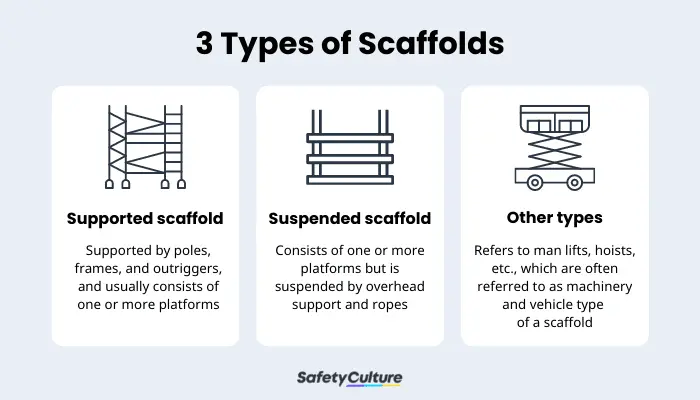
Scaffolds come in 3 different types:
- Supported scaffold – a type of scaffold that is supported by poles, frames, and outriggers, and usually consists of one or more platforms.
- Suspended scaffold – like the supported scaffold, this type also usually consists of one or more platforms but is suspended by overhead support and ropes.
- Other types – are man lifts, hoists, etc., which are often referred to as machinery and vehicle types of scaffolds.
OSHA Scaffolding Safety: Who is a Competent and Qualified Person?
According to OSHA, a competent person is “one who is capable of identifying existing and predictable hazards in the surroundings or working conditions, which are unsanitary, hazardous to employees, and who has authorization to take prompt corrective measures to eliminate them.” This is typically someone who holds a scaffolding high-risk work license.
A qualified person is one who “has successfully demonstrated his/her ability to solve or resolve problems related to the subject matter, the work, or the project.” A qualified person has the right background, such as education or degree, in designing safe scaffolding.
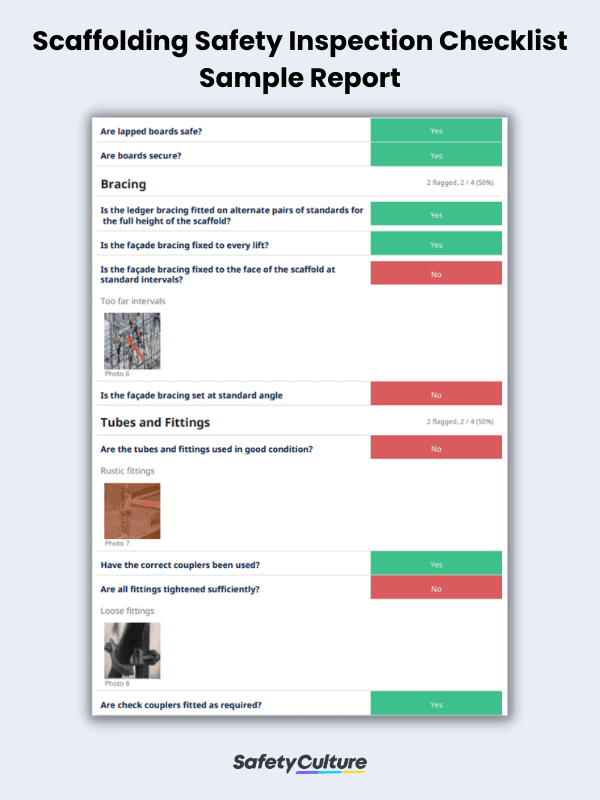
Scaffolding Safety Requirements: Basic Dos and Don’ts
Here’s a simple scaffolding requirements guide you can follow to control the hazards when working on a scaffold:
Scaffolding Safety Dos:
- Inspect the scaffold using a checklist or mobile inspection app before the work shift.
- Provide proper training.
- Have a toolbox talk before beginning work.
- Wear appropriate PPE.
- Always check inspection tags.
- Know the weight capacity of the scaffold.
- Have a handhold above the scaffold platform.
- Level the scaffold after each move. Do not extend adjusting leg screws more than 12 inches.
- Use your safety belts and lanyards when working on scaffolding at a height of 10 feet or more above ground level. Attach the lanyard to a secure member of the scaffold.
- Safely use the ladder when climbing the cross braces for access to the scaffold.
- Keep both feet on the decking.
- Stay off the scaffold during loading or unloading.
- Follow the manufacturer’s instructions when erecting the scaffold, under the direct supervision of a competent person.
- Be mindful of coworkers working above and below you at all times, as well as others working on the scaffold.
- Always use netting to catch anything that falls.
Scaffolding Safety Don’ts:
- Don’t leave anything on the scaffold at the end of your shift.
- Don’t overload the scaffold.
- Don’t use unstable objects to support scaffolds or increase your work height or planks.
- Don’t use the scaffold if it appears to be damaged in any way.
- Don’t walk on scaffold planking covered in ice, snow, or mud.
- Don’t use a scaffold during adverse weather conditions.
- Don’t lean out or overreach outside the guardrails.
- Don’t rock the scaffold.
- Don’t throw anything “overboard” unless a spotter is available.
- Don’t move a mobile scaffold if anyone is on it.
Improve your EHS Management
Cultivate a safe working environment and streamline compliance with our EHS solutions.
Explore nowScaffolding Safety Tips: How to Use a Scaffolding
See below for some simple steps to build and use scaffolding properly:
- Barricade the scaffolding area and put signage indicating an ongoing scaffolding structure.
- Find the corner point and align the scaffolding with the building.
- Assemble the parts of the first lift to set up positions for soleplates then ensure that they form a firm foundation for the scaffolding.
- Adjust the baseplates to accommodate uneven floors and grounds.
- Erect the first bay by starting at the highest point.
- Use a spirit level to align the bay, then alter the baseplates through baseplate adjustments.
- Check if the distance of the bay from the building is correct, then move it if required—use a lever to safely move the bay.
- Measure the diagonal dimensions of the bay or align the plates to make sure that they are squared.
- Set up the pins, wedges, upper transom, and ledgers, then complete the first bay.
- Create a working platform by arranging planks in a lift—this makes it easier to add the succeeding upper ledgers and transoms.
- Construct scaffold returns similar to how the other bays were structured.
- Connect the main scaffold to the return by tying them together using scaffold tubes and right-angled couplers.
- Install the standards for the next level then set up transoms and ledgers to function as temporary guard rails.
- Set up the working platform by arranging all the transoms and ledgers for the next lift.
- Continue to build the scaffold until the desired number and height of lifts are established.
- Arrange a working platform between the scaffold and the building by installing hop-up brackets.
- Inspect the scaffold to ensure safety before authorizing its use.
To perform a comprehensive scaffold inspection, you can use this Mobile Scaffold Safety Checklist developed by the Working at Height Association (WAHA). This ready-to-use template complies with the safety guidance outlined by Safe Work Australia when dealing with scaffold work.
Create your own Scaffolding Safety Checklist
Build from scratch or choose from our collection of free, ready-to-download, and customizable templates.
Browse Scaffold Inspection ChecklistScaffolding Safety Training
Scaffolding safety training is a collection of practical lessons to help employees develop skills for safely using scaffolds at work. Typical scaffold safety training includes access and usage requirements, capacity, and birdcage scaffolding and ladder beams, like in this free online course. Meanwhile, this Mobile Scaffold Safety course created by WAHA, specifically emphasizes the safe usage of mobile scaffolds at work.
Scaffold Tagging System and Meaning
Follow the guidelines below when tagging scaffolds.
- A unique scaffold identification tag number must be identified on all tags for tracking purposes.
- All scaffolds shall be inspected after the erection per regulatory requirements.
- All scaffold identification tags will be of a solid green, yellow, or red color with black lettering.
- Front information is displayed and completed for each tag.
Green Scaffold Tags
Meaning: Tags will be hung on scaffolds that have been inspected and are safe for use. A green “SAFE FOR USE” tag(s), and should be attached to the scaffold at each access point after the initial inspection is complete.
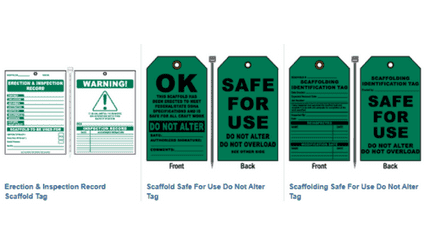
Yellow Scaffold Tags
Meaning: “CAUTION” tag(s), will replace all green “Safe Scaffold” tag(s) whenever the scaffold has been modified to meet work requirements, and as a result, could present a hazard to the user. This tag indicates special requirements for safe use.
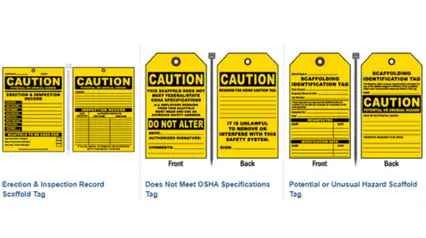
NOTE: Use of the “yellow tag” status is not intended to override the green tag system. All efforts should be made to return the scaffold to a “Green Tag” status as soon as possible.
Red Scaffold Tags
Meaning: “DANGER – UNSAFE FOR USE” tag(s), will be used during erection or dismantling when the scaffold is left unattended and replace all green “Safe for Use ” tag(s) or yellow “Caution / Hazard “ tag(s) in the event a scaffold has been deemed unfit for use.
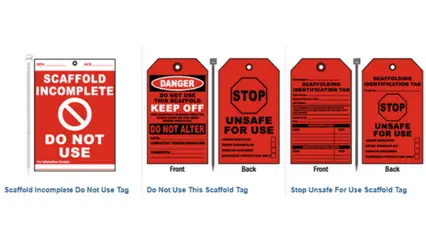
FAQs About Scaffolding Safety
The 3 to 1 rule for freestanding scaffolding towers states that the total working height of the scaffolding should be three times the distance of the narrowest side of its base. Moreover, if the height of the tower exceeds three times the narrowest side of the base, it should be secured to a suitable structure or braced with guy wires or other appropriate supports to ensure stability and prevent the risk of collapse.
The PPEs required when working on a scaffolding typically include hard hats, safety harnesses, safety shoes or heavy-duty boots, gloves, eye and face protection, and high-visibility vests or clothing.
Yes, OSHA requires employers to provide training to staff who work on or around any type of scaffolding. The training should be led by a qualified person and should include topics such as fall hazards, falling object hazards, electrical hazards, proper use of the scaffold, and handling of materials.
In general, scaffolding should be checked and inspected before being used for the first time, and then at regular intervals during its use. The specific frequency would depend on factors such as the type of scaffolding, the site condition, and whether it is exposed to extreme conditions that may affect its structural integrity.




